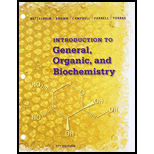
(a)
Interpretation:
The preparation of 250 mL of 3.6% w/v solution of NaCl in water should be explained.
Concept Introduction:
The concentration is shown as w/v meaning this is mass of solute per volume of solution.
Answer to Problem 6.36P
Explanation of Solution
Given Information:
Concentration has several ways to be calculated. It typically relates an amount of solute and the solution. Then given in mass of solute per unit volume of solution, or w/w, the total mass of the solute, solvent and solution must be known.
The formula for w/v is given as:
Substitute known data and solve for mass of solute.
Thus,
(b)
Interpretation:
The preparation of solution should be explained.
Concept Introduction:
The concentration is shown as w/v meaning this is mass of solute per volume of solution.
Answer to Problem 6.36P
Explanation of Solution
Given:
Concentration has several ways to be calculated. It typically relates an amount of solute and the solution. Then given in mass of solute per unit volume of solution, or w/w, the total mass of the solute, solvent and solution must be known.
The formula for w/v is given as:
Substitute known data and solve for mass of solute.
Thus,
(c)
Interpretation:
To calculate how to create the solution with the given concentration and volume.
Concept Introduction:
The concentration is shown as w/v meaning this is mass of solute per volume of solution.
(c)
Answer to Problem 6.36P
Explanation of Solution
Given:
Concentration has several ways to be calculated. It typically relates an amount of solute and the solution. Then given in mass of solute per unit volume of solution, or w/w, the total mass of the solute, solvent and solution must be known.
The formula for w/w is given as:
Substitute known data and solve for mass of solute.
Then, add
The solution should include solute and solvent amounts.
(d)
Interpretation:
To calculate how to create the solution with the given concentration and volume.
Concept Introduction:
The concentration is shown as w/v meaning this is mass of solute per volume of solution.
Answer to Problem 6.36P
Explanation of Solution
Given:
Concentration has several ways to be calculated. It typically relates an amount of solute and the solution. Then given in mass of solute per unit mass of solvent, or w/w, the total mass of the solute, solvent and solution must be known.
The formula for w/w is given as:
Substitute known data and solve for mass of solute.
Then, add
The solution should include solute and solvent amounts.
Want to see more full solutions like this?
Chapter 6 Solutions
Bundle: Introduction to General, Organic and Biochemistry, 11th + OWLv2, 4 terms (24 months) Printed Access Card
- 6-54 An industrial wastewater contains 3.60 ppb cadmium Cd2+. How many mg of Cd2+ could be recovered from a ton (1016 kg) of this wastewater?arrow_forward6-40 What is the molarity of each solution? (a) 47 g of KCI dissolved in enough water to give 375 mL of solution (b) 82.6 g of sucrose, C12H22O11, dissolved in enough water to give 725 mL of solution (c) 9.3 g of ammonium sulfate, (NH4)2SO4 dissolved in enough water to give 2.35 L of solutionarrow_forward6-37 Calculate the w/v percentage of each of these solutes: (a) 623 mg of casein in 15.0 mL of milk (b) 74 mg of vitamin C in 250 mL of orange juice (c) 3.25 g of sucrose in 186 mL of coffeearrow_forward
- 6-100 Which will have greater osmotic pressure? (a) A 0.9% w/v NaCI solution (b) A 25% w/v solution of a nondissociating dextran with a molecular weight of 15,000.arrow_forward6-99 A concentrated nitric acid solution contains 35% HNO3. How would we prepare 300. mL of 4.5% solution?arrow_forward6-35 Describe how we would prepare the following solutions: (a) 280. mL of a 27% v/v solution of ethanol C2H6O, in water (b) 435 mL of a 1.8% v/v solution of ethyl acetate, C4H8O2 in water (c) 1.65 L of an 8.00% v/v solution of benzene C6H6, in chloroform, CHCI3arrow_forward
- 6-25 A small amount of solid is added to a separatory funnel containing layers of diethyl ether and water. After shaking the separatory funnel, in which layer will we find each of the following solids? (a) NaCI (b) Camphor (C10H16O) (c) KOHarrow_forward6-96 We know that a 0.89% saline (NaCI) solution is isotonic with blood. In a real-life emergency, you run out of physiological saline solution and have only KCI as a salt and distilled water. Would it be acceptable to make a 0.89% aqueous KCI solution and use it for intravenous infusion? Explain.arrow_forward6-41 A teardrop with a volume of 0.5 mL contains 5.0 mg NaCI. What is the molarity of the NaCI in the teardrop?arrow_forward
- 6-15 Answer true or false. (a) A solute is the substance dissolved in a solvent to form a solution. (b) A solvent is the medium in which a solute is dissolved to form a solution. (c) Some solutions can be separated into their components by filtration. (d) Acid rain is a solution.arrow_forward6-48 How many grams of solute are present in each of the following aqueous solutions? (a) 575 mL of a 2.00 M solution of nitric acid, HNO3 (b) 1.65 L of a 0.286 M solution of alanine, C3H7NO2 (c) 320 mL of a 0.0081 M solution of calcium sulfate, CaSO4arrow_forward6-47 A student has a bottle labeled 0.750% albumin solution. The bottle contains exactly 5.00 mL. How much water must the student add to make the concentration of albumin become 0.125%?arrow_forward
 Introduction to General, Organic and BiochemistryChemistryISBN:9781285869759Author:Frederick A. Bettelheim, William H. Brown, Mary K. Campbell, Shawn O. Farrell, Omar TorresPublisher:Cengage Learning
Introduction to General, Organic and BiochemistryChemistryISBN:9781285869759Author:Frederick A. Bettelheim, William H. Brown, Mary K. Campbell, Shawn O. Farrell, Omar TorresPublisher:Cengage Learning
